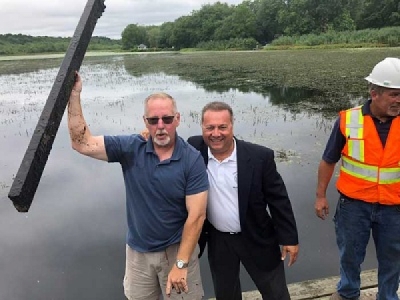
Posted on August 27, 2018
By removing the boards that hold together the dam at Lower Lake in Yaphank, the Town of Brookhaven officially began the process of draining and dredging the lake. Drainage is expected to continue through early winter.
The removed boards allows for increased water flow from the lake into the Carmans River, which empties into the Great South Bay. The town will then clean the lake bottom by ridding it of harmful contaminants that feed the invasive species. The goal is to restore the lake to clean waters with its natural habitat of wildlife.
“Our job is to restore the health of these lakes,” said supervisor Ed Romaine at a press conference early Monday. Romaine added that there were critical need to address the issue.
Present with the supervisor was councilman Michael Loguercio, who represents Yaphank, congressman Lee Zeldin, state Assemb. Dean Murray, Suffolk County Legis. Rudy Sunderman, councilman Dan Panico, and members of the Yaphank Civic Association and Yaphank Historical Society.
“This community has waited patiently for many years, and I am extremely pleased that, as I promised, I was able to make this dream come true for them,” Loguercio said. “The residents here, along with generations to come, will now be able to enjoy all of the amenities that this beautiful lake has to offer, such as boating, fishing and just admiring its incredible landscape.”
Sunderman said that this project was another testament to the collaboration of several levels of government. Similar to the fish ladder project that was approved a few weeks ago for the Carmans River, the town, county, and state governments were all part of this decision. At the state level, Murray and state Sen. Kenneth LaValle have been working with the Department of Environmental Conservation, which controls the Carmans River.
“What you see is so desperately in need of this attention, and the leadership of Brookhaven Town has now put us within reach,” Zeldin said.
According to Chad Trusnovec, vice president of the Yaphank Historical Society, the lake has been deteriorating for decades, due to what he calls reverse erosion. Harmful weeds have grown on the outer banks of the lake and proceeded inland, which have nested in the water, allowing other harmful plants to breed. When it was clear, the lake was about 8 to 10 feet deep, but now is approximately 5 to 6 feet deep at its lowest point. Another possible cause, according to town officials, is residents dumping personal aquariums into the lake, which mix native and nonnative species.
Loguercio and Romaine said that the process to dredge the Upper Lake, which was completed in 2013, was not an ideal way to run the project. Loguercio said the project used an unnecessary amount of resources at a higher cost. While the Upper Lake project cost $4 million, the Lower Lake project is expected to cost between $2 million and $2.5 million and will be cleaned using town resources.
“The lakes are the identity of this community,” Trusnovec said, noting the years of work he said it took to get this project to come together.
The species infestation in the lake prevents human recreation, as well as native ducks and trout use of the lake. The restoration will help to enhance the natural environment for the native species.
Source: The Long Island Advance





